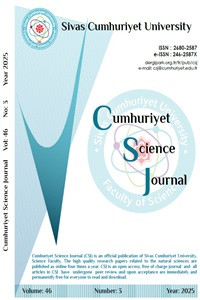Electric Field and Polarizer Angle-Dependent Optical Response of a Planar Liquid Crystal Cell Using Monte Carlo Simulations and Mueller matrix Analysis
Abstract
We investigate the optical response of a planar nematic liquid crystal (LC) cell under varying electric fields and polarizer orientations using a combination of Monte Carlo (MC) simulations and Mueller matrix formalism. The LC molecular configurations are generated using a Lebwohl–Lasher-type lattice model with periodic boundary conditions, electric field coupling, and surface anchoring interactions. These configurations are incorporated into a Mueller matrix framework to calculate the spectrally dependent transmittance through a crossed-polarizer setup for three primary wavelengths: red (λR=700 nm), green (λG=546.1 nm), and blue (λB=435.8 nm), corresponding to simply the RGB color channels, respectively. By systematically varying the polarizer azimuthal angle (𝛼=0⁰, -22.5⁰, and -45⁰), we demonstrate that both the transmitted intensities and the resulting color maps are strongly modulated by changes in electric field and crossed polarizer’s azimuthal angle. To visualize these effects, RGB-based color maps are constructed, providing an intuitive representation of the optical response as a function of system parameters. The results reveal a strong dependence of output intensity and color on the LC molecular orientation, confirming the capability of this simulation-based approach for designing tunable LC optical elements and display technologies.
Keywords
Monte Carlo simulation liquid crystal retarder polarization rotation external field modulation Mueller matrix
References
- [1] Andrienko D., Introduction to liquid crystals, Journal of Molecular Liquids, 267 (2018) 520-541.
- [2] García-García A., VergazR., Algorri J. F., Quintana X., Otón J. M., Electrical response of liquid crystal cells doped with multi-walled carbon nanotubes, Beilstein Journal of Nanotechnology, 6 (1) (2015), 396-403.
- [3] Jayasri D., Satyavathi N., Sastry V. S. S., Murthy K. P. N., Phase transition in liquid crystal elastomer - a Monte Carlo study employing non-Boltzmann sampling, Physica A, 388 (4) (2006) 13-13.
- [4] Lagerwall J. P. F., Scalia G., A new era for liquid crystal research: Applications of liquid crystals in soft matter nano-, bio- and microtechnology, Current Applied Physics, 12 (6) 1387-1412.
- [5] Woltman S. J., Jay G. D., Crawford G. P., Liquid-crystal materials find a new order in biomedical applications, Nature Materials, 6 (12) (2007) 929-938.
- [6] Nahum G., Imaging spectroscopy using tunable filters: a review, Proc.SPIE, 4056 (2000) 50-64.
- [7] Emül Y, Polat Ö., San S. E., Kayacan Ö. Özbek H., Investigating electro-optical properties of a nematic liquid crystal cell with planar anchoring boundary condition for various thicknesses: A Monte Carlo study, Optical Materials, 36 (8) (2014) 1373-1377.
- [8] Emül Y., Monte carlo simulations for tuning optical properties in a two-stage liquid crystal retarder system via Mueller matrix method, Liquid Crystals, 52(3-4) (2024) 212-219.
- [9] Lebwohl P. A., Lasher G., Nematic-Liquid-Crystal Order---A Monte Carlo Calculation, Phys. Rev. A, 6 (1) (1972), 426-429.
- [10] Zhang Z., Mouritsen O. G., Zuckermann M. J., Weak first-order orientational transition in the Lebwohl-Lasher model for liquid crystals, Physical Review Letters, 69 (19) (1992) 2803-2806.
- [11] Rapini A., Papoular M., Distorsion d'une lamelle nématique sous champ magnétique conditions d'ancrage aux parois, J. Phys. Colloques, 30 (C4) (1969) C4-54 - C4-56.
- [12] Rapini A., Papoular M., Ondes de surface dans un cristal liquide nématique, J. Phys. Colloques, 31 (C1) (1970) C1-27 - C1-28.
- [13] Pawlik G., Mitus A. C., Karpinski P., Miniewicz A., Laser light-induced molecular reorientation in 90° twisted nematic liquid crystal: Classic approach, Monte Carlo modeling and experiment, Optical Materials, 34 (10) (2012) 1697-1703.
- [14] Xu F., Kitzerow H. S., Crooker P. P., Electric-field effects on nematic droplets with negative dielectric anisotropy, Phys. Rev. A, 46 (10) (1992) 6535–6540.
- [15] Goldstein D. H., Polarized light, CRC Press, (2011) 50-134.
- [16] Zia A., Saeed S., Man T., Liu H., Chen C. X., Wan Y., Next-generation interfaces: integrating liquid crystal technologies in augmented and virtual reality - A review, Liquid Crystals Reviews, 12(1) (2024), 30–56.
Details
| Primary Language | English |
|---|---|
| Subjects | Atomic and Molecular Physics, Classical and Physical Optics |
| Journal Section | Natural Sciences |
| Authors | |
| Publication Date | September 30, 2025 |
| Submission Date | July 11, 2025 |
| Acceptance Date | September 15, 2025 |
| Published in Issue | Year 2025 Volume: 46 Issue: 3 |

